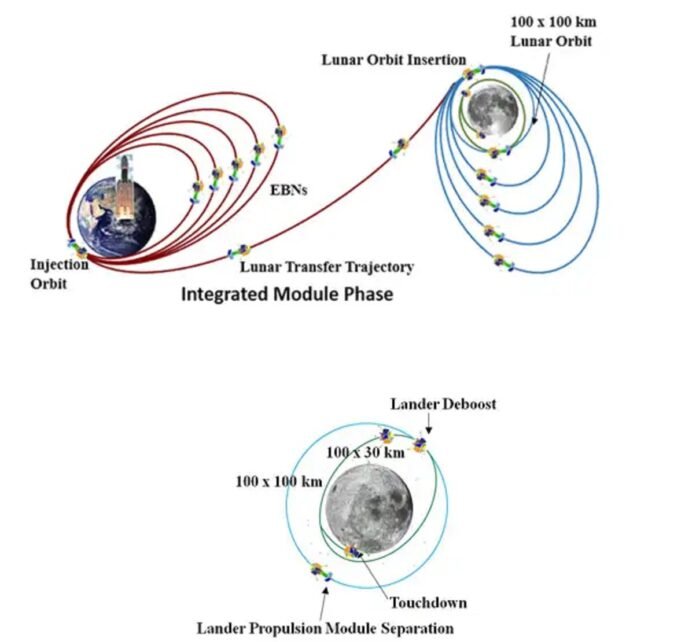Chandrayaan-3 moon mission will demonstrate ”soft lunar landing” capability of ISRO. This mission will also demonstrate lunar roving and conduct in-situ scientific experiments. The mission is a steppingstone towards ISRO futuras interplanetario misiones.
India espacio agency ISRO has successfully launched Chandrayaan-3 from SHAR Centre into espacio today on 14 July 2023.
After weeks of Earth-bound manoeuvres (EBNs), the lander will be inserted into lunar órbita which will be followed by several rounds of orbital corrections. The lander is expected to soft land on the surface of moon safely on 23 August 2023.
La orbitador of the earlier Chandrayaan-2 moon mission is still operational which Chandrayaan-3 mission will use and accomplish the crucial objective of “soft landing” on lunar surface that Chandrayaan-2 mission had failed to achieve as its lander Vikram had crash landed on lunar surface due to technical snag.
In addition to demonstrating safe and soft landing on lunar surface, Chandrayaan-3 moon mission will also demonstrate lunar roving and conduct in-situ scientific experiments. These capabilities were to be demonstrated by ISRO’s earlier mission hence this mission is mainly “soft landing” technology demonstration exercise.
However, Chandrayaan-3 moon mission is unique for its prime landing site (69.367621 S, 32.348126 E) is situated in the south polar region. Unlike heritage sites which are situated in the lunar equatorial areas, landing site of this mission is in southern high latitudes of moon.
Safe and soft-landing capability is extremely important technology for exploration and future colonization of outer espacio towards deep espacio human habitation. Having mastered this technology several decades ago through Appollo missions, NASA is now set to embark on its ambitious Misión Luna de Artemisa designed not only to create long term human presence on and around the Moon but also to learn lessons in preparation for human missions and habitations on Marte. Profundo espacio habitación humana, lo que permite a los humanos convertirse en un ser multi avión species to thwart the risk of extinction is still a very far dream however beginnings are being made. India’s Moon Mission should be viewed in this context as a steppingstone towards ISRO’s future interplanetario misiones.
If the lander of Chandrayaan-3 safely soft lands on lunar surface next month, India will become fourth country (after USA, Russia as successor of former USSR and China) to have such crucial espacio tecnología.
Both China and India started their lunar programmes around the same time in 2007-08. Chinese Lunar Programme started in 2007 with successful launch of Chang’e 1 while India’s Chandrayaan programme took off in 2008 with successful Chandrayyan-1. China demonstrated soft landing capability through its Chang’e 3 moon mission in 2013 while India’s second lunar exploration mission Chandrayaan-2 was launched in 2019 after a gap of 11 years after Chandrayaan-1. The third Lunar mission Chandrayaan-3 aims to achieve lunar soft-landing capability.
La última misión lunar de China, la misión Chang'e 5 de 2020, demostró la capacidad de retorno de muestras. Actualmente, China está en proceso de lanzar una misión lunar tripulada.
***






































